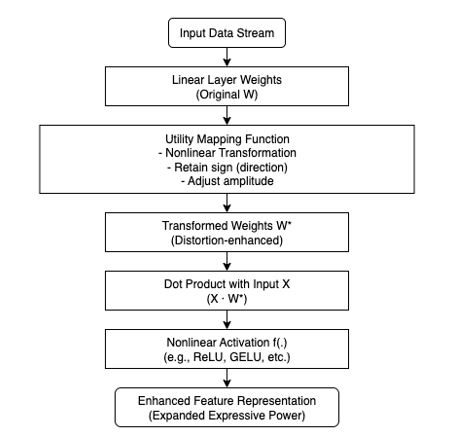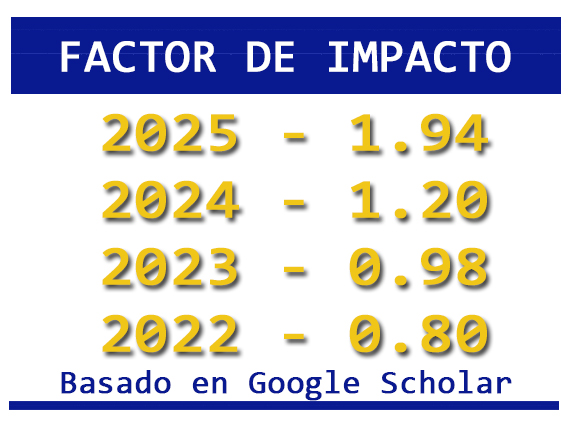A Novel Utility-Based Nonlinear Mapping Mechanism for Enhancing Linear Layers in Neural Networks
DOI:
https://doi.org/10.36790/epistemus.v19i38.442Keywords:
Utility-Based Transformation, Nonlinear Weight Mapping, Neural Network Enhancement, Plug-and-Play Mechanism, General Linear Layer ReplacementAbstract
This paper proposes a new universal linear transformation mechanism, inspired by the von Neumann-Morgenstern utility theory, known as the Von Neumann–Morgenstern Mechanism (VNM). This mechanism structurally reconstructs the linear layer in the neural network by introducing the "utility transformation" method to the traditional linear weights. Experiments on the image classification task CIFAR-10 have shown that the model using the VNM mechanism has obvious performance improvements over traditional methods in multiple evaluation indicators, showing stronger stability and generalization ability. This paper emphasizes that the mechanism has wide portability and is suitable for linear transformation modules in various neural network structures, providing a new idea for designing more effective deep learning models.
Downloads
References
A. M. Atto, S. Galichet, D. Pastor, and N. Méger, “On joint parameterizations of linear and nonlinear functionals in neural networks,” Neural Netw., vol. 160, pp. 12–21, 2023. https://doi.org/10.1016/j.neunet.2022.12.019 DOI: https://doi.org/10.1016/j.neunet.2022.12.019
A. Mehrish, N. Majumder, R. Bharadwaj, R. Mihalcea, and S. Poria, “A review of deep learning techniques for speech processing,” Inf. Fusion, vol. 99, p. 101869, 2023. https://doi.org/10.1016/j.inffus.2023.101869 DOI: https://doi.org/10.1016/j.inffus.2023.101869
S. Khullar and N. Singh, “Water quality assessment of a river using deep learning Bi-LSTM methodology: forecasting and validation,” Environ. Sci. Pollut. Res., vol. 29, no. 9, pp. 12875–12889, 2022. https://doi.org/10.1007/s11356-021-13875-w DOI: https://doi.org/10.1007/s11356-021-13875-w
J. Z. HaoChen, C. Wei, A. Gaidon, and T. Ma, “Provable guarantees for self-supervised deep learning with spectral contrastive loss,” Adv. Neural Inf. Process. Syst., vol. 34, pp. 5000–5011, 2021.
R. Hernández Medina et al., “Machine learning and deep learning applications in microbiome research,” ISME Commun., vol. 2, no. 1, p. 98, 2022. https://doi.org/10.1038/s43705-022-00182-9 DOI: https://doi.org/10.1038/s43705-022-00182-9
Y. Li, B. Sixou, and F. Peyrin, “A review of the deep learning methods for medical images super resolution problems,” IRBM, vol. 42, no. 2, pp. 120–133, 2021. https://doi.org/10.1016/j.irbm.2020.08.004 DOI: https://doi.org/10.1016/j.irbm.2020.08.004
I. J. Jacob and P. E. Darney, “Design of deep learning algorithm for IoT application by image based recognition,” J. ISMAC, vol. 3, no. 03, pp. 276–290, 2021. https://doi.org/10.36548/jismac.2021.3.008 DOI: https://doi.org/10.36548/jismac.2021.3.008
H. Chen, Y. Wang, J. Guo, and D. Tao, “Vanillanet: the power of minimalism in deep learning,” Adv. Neural Inf. Process. Syst., vol. 36, pp. 7050–7064, 2023.
M. N. Fekri, H. Patel, K. Grolinger, and V. Sharma, “Deep learning for load forecasting with smart meter data: Online Adaptive Recurrent Neural Network,” Appl. Energy, vol. 282, p. 116177, 2021. https://doi.org/10.1016/j.apenergy.2020.116177 DOI: https://doi.org/10.1016/j.apenergy.2020.116177
W. Albattah et al., “A novel deep learning method for detection and classification of plant diseases,” Complex Intell. Syst., pp. 1–18, 2022. https://doi.org/10.1007/s40747-021-00536-1 DOI: https://doi.org/10.1007/s40747-021-00536-1
S. F. Ahmed et al., “Deep learning modelling techniques: current progress, applications, advantages, and challenges,” Artif. Intell. Rev., vol. 56, no. 11, pp. 13521–13617, 2023. https://doi.org/10.1007/s10462-023-10466-8 DOI: https://doi.org/10.1007/s10462-023-10466-8
G. Menghani, “Efficient deep learning: A survey on making deep learning models smaller, faster, and better,” ACM Comput. Surv., vol. 55, no. 12, pp. 1–37, 2023. https://doi.org/10.1145/3578938 DOI: https://doi.org/10.1145/3578938
A. Haridasan, J. Thomas, and E. D. Raj, “Deep learning system for paddy plant disease detection and classification,” Environ. Monit. Assess., vol. 195, no. 1, p. 120, 2023. https://doi.org/10.1007/s10661-022-10656-x DOI: https://doi.org/10.1007/s10661-022-10656-x
A. K. Sharma et al., “Classification of Indian classical music with time-series matching deep learning approach,” IEEE Access, vol. 9, pp. 102041–102052, 2021. https://doi.org/10.1109/ACCESS.2021.3093911 DOI: https://doi.org/10.1109/ACCESS.2021.3093911
S. Fresca and A. Manzoni, “POD-DL-ROM: Enhancing deep learning-based reduced order models for nonlinear parametrized PDEs by proper orthogonal decomposition,” Comput. Methods Appl. Mech. Eng., vol. 388, p. 114181, 2022. https://doi.org/10.1016/j.cma.2021.114181 DOI: https://doi.org/10.1016/j.cma.2021.114181
X. Chen et al., “Recent advances and clinical applications of deep learning in medical image analysis,” Med. Image Anal., vol. 79, p. 102444, 2022. https://doi.org/10.1016/j.media.2022.102444 DOI: https://doi.org/10.1016/j.media.2022.102444
Y. Zhang and Y. F. Li, “Prognostics and health management of Lithium-ion battery using deep learning methods: A review,” Renew. Sustain. Energy Rev., vol. 161, p. 112282, 2022. https://doi.org/10.1016/j.rser.2022.112282 DOI: https://doi.org/10.1016/j.rser.2022.112282
A. Mohan, A. K. Singh, B. Kumar, and R. Dwivedi, “Review on remote sensing methods for landslide detection using machine and deep learning,” Trans. Emerg. Telecommun. Technol., vol. 32, no. 7, e3998, 2021. https://doi.org/10.1002/ett.3998 DOI: https://doi.org/10.1002/ett.3998
M. Hakim et al., “A systematic review of rolling bearing fault diagnoses based on deep learning and transfer learning,” Ain Shams Eng. J., vol. 14, no. 4, p. 101945, 2023. https://doi.org/10.1016/j.asej.2022.101945 DOI: https://doi.org/10.1016/j.asej.2022.101945
C. C. Ukwuoma et al., “Recent advancements in fruit detection and classification using deep learning techniques,” Math. Probl. Eng., vol. 2022, no. 1, p. 9210947, 2022. https://doi.org/10.1155/2022/9210947 DOI: https://doi.org/10.1155/2022/9210947
R. Archana and P. E. Jeevaraj, “Deep learning models for digital image processing: a review,” Artif. Intell. Rev., vol. 57, no. 1, p. 11, 2024. https://doi.org/10.1007/s10462-023-10631-z DOI: https://doi.org/10.1007/s10462-023-10631-z
H. A. Helaly, M. Badawy, and A. Y. Haikal, “Deep learning approach for early detection of Alzheimer’s disease,” Cogn. Comput., vol. 14, no. 5, pp. 1711–1727, 2022. https://doi.org/10.1007/s12559-021-09946-2 DOI: https://doi.org/10.1007/s12559-021-09946-2
Y. Matsuzaka and Y. Uesawa, “A molecular image-based novel QSAR approach: deepsnap-deep learning,” Curr. Issues Mol. Biol., vol. 42, no. 1, pp. 455–472, 2021. https://doi.org/10.21775/cimb.042.455 DOI: https://doi.org/10.21775/cimb.042.455
S. Singh and A. Mahmood, “The NLP cookbook: modern recipes for transformer based deep learning architectures,” IEEE Access, vol. 9, pp. 68675–68702, 2021. https://doi.org/10.1109/ACCESS.2021.3077350 DOI: https://doi.org/10.1109/ACCESS.2021.3077350
T. L. Chaunzwa et al., “Deep learning classification of lung cancer histology using CT images,” Sci. Rep., vol. 11, no. 1, pp. 1–12, 2021. https://doi.org/10.1038/s41598-021-84630-x DOI: https://doi.org/10.1038/s41598-021-84630-x
H. Kaur, S. U. Ahsaan, B. Alankar, and V. Chang, “A proposed sentiment analysis deep learning algorithm for analyzing COVID-19 tweets,” Inf. Syst. Front., vol. 23, no. 6, pp. 1417–1429, 2021. https://doi.org/10.1007/s10796-021-10135-7 DOI: https://doi.org/10.1007/s10796-021-10135-7
C. Dimas, V. Alimisis, N. Uzunoglu, and P. P. Sotiriadis, “Advances in electrical impedance tomography inverse problem solution methods,” IEEE Access, vol. 12, pp. 47797–47829, 2024. https://doi.org/10.1109/ACCESS.2024.3382939 DOI: https://doi.org/10.1109/ACCESS.2024.3382939
U. S. Rao et al., “Deep learning precision farming: grapes and mango leaf disease detection by transfer learning,” Glob. Transit. Proc., vol. 2, no. 2, pp. 535–544, 2021. https://doi.org/10.1016/j.gltp.2021.08.002 DOI: https://doi.org/10.1016/j.gltp.2021.08.002
G. Roeder, L. Metz, and D. Kingma, “On linear identifiability of learned representations,” in Proc. Int. Conf. Mach. Learn. (ICML), pp. 9030–9039, Jul. 2021.
S. Yu and J. Ma, “Deep learning for geophysics: Current and future trends,” Rev. Geophys., vol. 59, no. 3, e2021RG000742, 2021. https://doi.org/10.1029/2021RG000742 DOI: https://doi.org/10.1029/2021RG000742
A. Gasparin, S. Lukovic, and C. Alippi, “Deep learning for time series forecasting: The electric load case,” CAAI Trans. Intell. Technol., vol. 7, no. 1, pp. 1–25, 2022. https://doi.org/10.1049/cit2.12060 DOI: https://doi.org/10.1049/cit2.12060
I. H. Sarker, “Deep cybersecurity: a comprehensive overview from neural network and deep learning perspective,” SN Comput. Sci., vol. 2, no. 3, p. 154, 2021. https://doi.org/10.1007/s42979-021-00535-6 DOI: https://doi.org/10.1007/s42979-021-00535-6
M. Li et al., “A deep learning method of water body extraction from high resolution remote sensing images with multisensors,” IEEE J. Sel. Top. Appl. Earth Obs. Remote Sens., vol. 14, pp. 3120–3132, 2021. https://doi.org/10.1109/JSTARS.2021.3060769 DOI: https://doi.org/10.1109/JSTARS.2021.3060769
M. S. Ismail and R. Peeters, “A connection between von Neumann-Morgenstern expected utility and symmetric potential games,” Theory Decis., pp. 1–14, 2024. https://doi.org/10.2139/ssrn.4615620 DOI: https://doi.org/10.2139/ssrn.4615620
R. Van Den Brink and A. Rusinowska, “Degree centrality, von Neumann–Morgenstern expected utility and externalities in networks,” Eur. J. Oper. Res., vol. 319, no. 2, pp. 669–677, 2024. https://doi.org/10.1016/j.ejor.2024.06.042 DOI: https://doi.org/10.1016/j.ejor.2024.06.042
J. Lopez-Wild, “A computable von Neumann-Morgenstern representation theorem,” Synthese, vol. 205, no. 5, p. 182, 2025. https://doi.org/10.1007/s11229-025-04980-1 DOI: https://doi.org/10.1007/s11229-025-04980-1
N. N. Osipov, “Von Neumann–Morgenstern Axioms of Rationality and Inequalities in Analysis,” J. Math. Sci., vol. 285, no. 1, pp. 142–153, 2024. https://doi.org/10.1007/s10958-024-07439-9 DOI: https://doi.org/10.1007/s10958-024-07439-9
N. T. Wilcox, “Utility measurement: Some contemporary concerns,” in A Modern Guide to Philosophy of Economics, Edward Elgar, pp. 14–27, 2021. https://doi.org/10.4337/9781788974462.00007 DOI: https://doi.org/10.4337/9781788974462.00007
J. C. Francis, “Harry Markowitz’s contributions to utility theory,” Ann. Oper. Res., vol. 346, no. 1, pp. 113–125, 2025. https://doi.org/10.1007/s10479-024-06210-2 DOI: https://doi.org/10.1007/s10479-024-06210-2
J. C. Francis, “Reformulating prospect theory to become a von Neumann–Morgenstern theory,” Rev. Quant. Finance Account., vol. 56, no. 3, pp. 965–985, 2021. https://doi.org/10.1007/s11156-020-00915-8 DOI: https://doi.org/10.1007/s11156-020-00915-8
J. GarcÍa Cabello, “A New Decision Making Method for Selection of Optimal Data Using the Von Neumann-Morgenstern Theorem,” Informatica, vol. 34, no. 4, pp. 771–794, 2023. https://doi.org/10.15388/23-INFOR530 DOI: https://doi.org/10.15388/23-INFOR530
B. Hu and F. Yuan, "Utility-Probability Duality of Neural Networks," *arXiv preprint arXiv:2305.14859*, May 2023.

Downloads
Published
How to Cite
Issue
Section
License
Copyright (c) 2025 EPISTEMUS

This work is licensed under a Creative Commons Attribution-NonCommercial-ShareAlike 4.0 International License.
The magazine acquires the patrimonial rights of the articles only for diffusion without any purpose of profit, without diminishing the own rights of authorship.
The authors are the legitimate owners of the intellectual property rights of their respective articles, and in such quality, by sending their texts they express their desire to collaborate with the Epistemus Magazine, published biannually by the University of Sonora.
Therefore, freely, voluntarily and free of charge, once accepted the article for publication, they give their rights to the University of Sonora for the University of Sonora to edit, publish, distribute and make available through intranets, Internet or CD said work, without any limitation of form or time, as long as it is non-profit and with the express obligation to respect and mention the credit that corresponds to the authors in any use that is made of it.
It is understood that this authorization is not an assignment or transmission of any of your economic rights in favor of the said institution. The University of Sonora guarantees the right to reproduce the contribution by any means in which you are the author, subject to the credit being granted corresponding to the original publication of the contribution in Epistemus.
Unless otherwise indicated, all the contents of the electronic edition are distributed under a license for use and Creative Commons — Attribution-NonCommercial-ShareAlike 4.0 International — (CC BY-NC-SA 4.0) You can consult here the informative version and the legal text of the license. This circumstance must be expressly stated in this way when necessary.
The names and email addresses entered in this journal will be used exclusively for the purposes established in it and will not be provided to third parties or for their use for other purposes.














